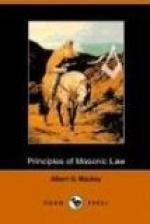It is, however, but fair to state that the remaining clause of the old charge, which asserts that the candidate must have no maim or defect that may render him incapable of learning the art, has been supposed to intend a modification of the word “perfect,” and to permit the admission of one whose maim or defect was not of such a nature as to prevent his learning the art of Masonry. But I would respectfully suggest that a criticism of this kind is based upon a mistaken view of the import of the words. The sentence is not that the candidate must have no such maim or defect as might, by possibility, prevent him from learning the art; though this is the interpretation given by those who are in favor of admitting slightly maimed candidates. It is, on the contrary, so worded as to give a consequential meaning to the word “that.” He must have no maim or defect that may render him incapable; that is, because, by having such maim or defect, he would be rendered incapable of acquiring our art.
In the Ahiman Rezon published by Laurence Dermott in 1764, and adopted for the government of the Grand Lodge of Ancient York Masons in England, and many of the Provincial Grand and subordinate lodges of America, the regulation is laid down that candidates must be “men of good report, free-born, of mature age, not deformed nor dismembered at the time of their making, and no woman or eunuch.” It is true that at the present day this book possesses no legal authority among the craft; but I quote it, to show what was the interpretation given to the ancient law by a large portion, perhaps a majority, of the English and American Masons in the middle of the eighteenth century.




